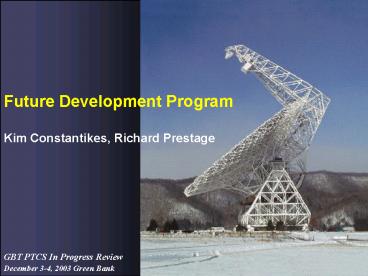Future Development Program - PowerPoint PPT Presentation
Title:
Future Development Program
Description:
Production Q-band (50GHz) operation (pointing/focus, surface ... Surface / collimation improvements. Extend over grav, temp, wind. Improve FEM. Surface Peak-up ... – PowerPoint PPT presentation
Number of Views:36
Avg rating:3.0/5.0
Title: Future Development Program
1
Future Development Program
- Kim Constantikes, Richard Prestage
2
PTCS / High Frequency Environmental Envelope
s
s
3
Goals for October 2004/Early 2005
- Production Q-band (50GHz) operation
(pointing/focus, surface efficiency/beamshape)
under benign conditions. - Extend Q-band capabilities to normal
conditions. - Prototype W-band (92GHz) performance under
benign conditions for engineering commissioning
of Penn Array Receiver.
4
Approach
- Incremental approach using combination of
traditional techniques and innovative use of
simple technology (temperature sensors,
inclinometers, holography). - Laser rangefinders in specific roles if needed.
- Concrete intermediate deliverables.
- Attempting to correct for effects on timescales
of 1min or longer. No need to address gt1Hz
effects at this time. - gt No need for new control
architecture yet.
5
Approach
Instrumentation
Pointing/Focus
Algorithms
Astronomical Measurements
Efficiency/Beamshape
Instrumentation
Algorithms
Astronomical Measurements
6
Instrumentation and Algorithms
Prototyping, Commissioning Experiments and
Transition to Production Capabilities
Enable W-Band Performance Under Benign
Conditions and Q-Band Performance Under Normal
Conditions
7
Phased Approach Surface Improvements I
- Benign conditions only
- Static improvements at geostationary satellite
(rigging angle) elevation Holography. - Extend over elevation Holography, FEM
improvements. - Refined active surface control/data processing
Better knobs - Short campaign December?
- Extensive campaign February.
8
Phased Approach Surface Improvements II
- Extended thermal environments
- Simple thermal corrections (more BUS sensors,
thermal imaging, models) - Astronomical peak-ups
- Prototype/Prepare during Summer 2004
- Highest priority for October 2004.
9
Phased Approach Pointing
- Effects
- Az track irregularities
- 10s of seconds to minute timescale wind.
- Instruments
- Inclinometer
- Star Tracker
- Complete/install instrumentation Spring 2004
- Prototype/Commission Summer 2004 (astronomical
experiments at optical, C and X-band)
10
Other Items I
- Completion of current work
- Production version of dynamic temp corrections
- Production version of thermal stability monitor
- Prototype installation of inclinometers
- Active Surface Control System Upgrade
- Need to refactor Active Surface manager for
flexible, convenient control (e.g. Zernike
polynomials, SOAP) - Antenna Manager Improvements
- Completion of pointing/focus model work
- Trajectory calculation improvements
- May need dynamic corrections to subreflector (0.1
Hz)
11
Other Items II
- Need to be able to characterize conditions for
high-frequency observing - Site Interferometer
- Radiometer
- Climate
- Cannot address these with resources currently
available to PTCS group
12
Summary
- Address performance improvements incrementally.
- Productionize thermal improvements
- Development priorities Wind, az track, surface
phase I - We have the real antenna available to us use
it! - Many original concerns have turned out to be less
important than expected. - Only need to address ltlt 1Hz effects in coming
year.
13
Schedule
Production Q-band, Engineering W-band for winter
2004
Q4 2003
Q1 2004
Q2 2004
Q3 2004
Production versions Dynamic pointing/focus
Static Surface Accuracy improvements
Pointing Instrumentation/ Techniques
Pointing Commissioning Experiments/ production use
Surface Improvements II
Q-band under normal conditions W-band under
benign conditions































